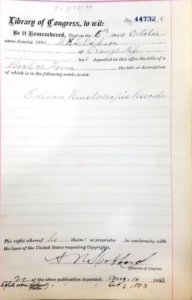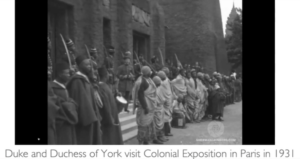By Conorr Norquay
For Domitor’s seventeenth international conference, scholars were invited to consider copyright’s legal, political and sociocultural relevance throughout the first two decades of cinema’s inception. Questions of who owns the rights to copy film, and the ways in which these rights determine the legality of who may copy, distribute and exhibit motion pictures were at the forefront of this year’s conference, as forty presenters sought to elucidate copyright’s place within the landscape of authorship, ownership, piracy and privacy in early cinema’s history. Piracy’s role in accelerating the development of an international film industry was given a significant spotlight, as was its place within early legal cases and their regulation of commodity ownership over an emerging new medium. Yet, other rights beyond the screen were investigated as well. Intermedial copyrights for theatrical performances or film adaptations of written and visual works were showcased, in conjunction with an exploration of privacy rights and the limitations of an individual’s decision to be filmed or not. And, as with any examination of rights, an intersectional awareness of gender, sexuality, race, ethnicity, class and nationality was observed to reveal the restrictions an individual may have to accessing these rights—many of which persist to the present day.
Several presenters investigated the tensions between copyright’s traditional definitions and film as a new, unregulated object outside of its contexts within early cinema’s history. With the conference held in the year of the 110th anniversary of motion picture copyright’s birth, it was no surprise that Ainsworth Rand Spofford’s Paper Print Collection at the Library of Congress was given attention, a collection wherein paper contact prints of motion pictures were submitted to the U.S. Copyright Office for copyright protection prior to celluloid’s inclusion as a protected media type in 1912. Claudy Op den Kamp’s presentation explored the history of this collection’s formation and its relationship with intellectual property modernization, while re-examining the first film copyright registrations by W.K.L. Dickson. In doing so, Kamp invited us to consider the link between film historiography and copyright, and the transitionary period in which film producers self-determined the format of their copyright deposits before the U.S. Copyright Office adapted. Early motion pictures’ legal context was further examined in Zvi S. Rosen’s presentation on the evolution of copyright law in the United States. Rosen illustrated how early film submissions were rejected for failing to align with protected media types, instead forcing producers to register their works as books or photographs to achieve legal protection. Kamp and Rosen’s work obligates us to reconsider the historical narrative of early film and copyright and provides excellent insight into the ways in which emerging mediums can supersede traditional legal frameworks.
 Example of W.K.L. Dickson’s copyright registration for Edison Kinetoscopic Records as a “book or form” from Zvi S. Rosen’s presentation.
Example of W.K.L. Dickson’s copyright registration for Edison Kinetoscopic Records as a “book or form” from Zvi S. Rosen’s presentation.
As many panelists were quick to demonstrate, piracy complicates the accepted canon of early film history and compromises the foundation of copyright itself. Jane M. Gaines’ presentation scrutinized the role of “legal” piracy in both Thomas Edison’s patent litigation and legal duping of foreign films, to conclude that America was birthed as a “pirate nation,” and that a refusal to honor foreign copyrights created legalized forms of film piracy. In her words, “this struggle for copyright in moving pictures is not a story about the triumph of legal reasoning. Rather, it’s a battle over how to rationalize the guarantee of monopoly rights.” In this spirit, Hunter Koch’s work elaborated on Edison’s use of patent litigation to substantiate his copyright ownership and attack Siegmund Lubin’s duping empire. Edison’s patents were wielded to monopolistic ends, and through his simultaneous copyright and patent litigation brought to light their overlapping relationship. Gaines and Koch’s presentations explicate piracy’s function in the development of an international film industry and invite us to reevaluate copyright’s role in early film history as a tool used for monopolistic ownership over a new medium.
Meanwhile, postcolonial considerations of rights and cultural ownership were also contemplated by many Domitor presenters, as exemplified in the works of Alison Griffiths, Mark Williams and Aboubakar Sanogo. In her analysis of early amateur films of the Inter-Tribal Indian Ceremonial of Gallup, New Mexico, Griffiths argued that the effect of viewing these films creates a culturally subjective discursive space for storytelling, one wherein prior Indigenous ways of life reactivate memory within the viewer, and in this process of cultural memory recollection produce something wholly new. This process decolonizing the Eurocentricity embedded in early film historiography was also explored within Aboubakar Sanogo’s reinsertion of Africa into the historical narrative of early cinema, in his biographical overview of Albert Samama Chikly, an early Tunisian pioneer in motion pictures whose role in cinema’s foundations were purposefully obscured within colonial histories. Similarly, Mark Williams’ presentation surveyed “The Idea of Africa” present in collections of early film within American archives and contemplated the use of motion pictures as a technology wielded by a colonial power for racial othering. In doing so, Williams’ work concludes African cinema to be a “postcolonial visual pedagogy” that actively resists colonial perceptions and re-determines the ways in which Africa is to be seen and signified. Griffiths, Williams and Sanogo’s work demonstrate several methods in which colonial histories can be deconstructed to posit alternative, decolonized narratives that reassert the rights of authorship and ownership in film historiography to Indigenous and non-European communities.

Still of an ethnographic film of Africa produced in 1931.
As this cursory review illustrates,the 2022 symposium brought attention to a multiplicity of understudied sites and practices and identified new opportunities ripe for early cinema scholarship. The conference’s animated and provocative conversations served as a wonderful forum to explore the issues of copyrights and, more specifically, copies and rights within an economy of reproduction. With early film history an ever-evolving field, the fruitful discussions held within Domitor’s seventeenth international conference provide an excellent roadmap into future research, and reaffirm the significance of copy/rights.


